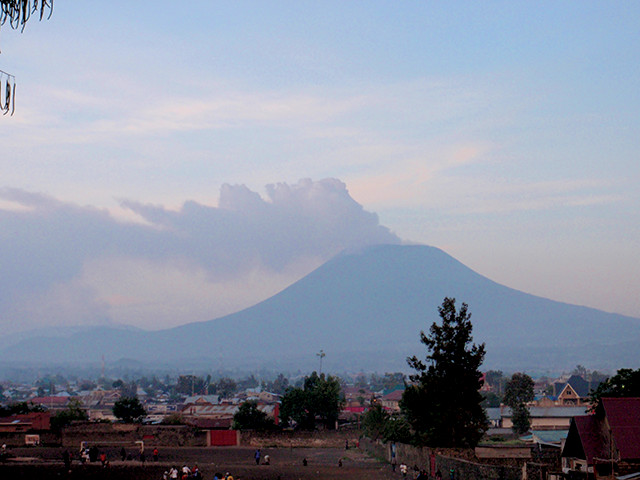
by Mary Caperton Morton Friday, May 20, 2016

The deadly January 2002 eruption of the Nyiragongo Volcano in the Democratic Republic of the Congo also triggered a damaging earthquake in October 2002 near Lake Kivu. Credit: Christelle Wauthier/Penn State.
In January 2002, Nyiragongo Volcano erupted in the Democratic Republic of the Congo, killing more than 100 people. Eight months later and 19 kilometers to the south, a magnitude-6.2 earthquake shook the Lake Kivu region, partially destroying the town of Kalehe. Now, scientists have determined that the two events were linked, and their results highlight a newly observed trigger for strong earthquakes near active volcanoes.
“When you have two events strike the same area within a few months of each other, you have to wonder if they’re linked in some way,” says Christelle Wauthier, a geophysicist at Penn State University and lead author of the new study published in Geochemistry, Geophysics, Geosystems.
Wauthier and colleagues used remote sensing radar data to analyze the shape of the ground surface between Nyiragongo and Lake Kivu before and after both the eruption and the earthquake. Based on the observed ground deformation, they inferred that a 19-kilometer-long dike intrusion, running between the volcano and the epicenter of the earthquake, had formed. Dike intrusions are common in this part of the world, where the East African Rift system is creating an extensional tectonic environment. As Earth’s crust is pulled apart by extensional forces, magma rises to the surface, forming vertical magmatic intrusions called dikes.
Dike formation has been known to trigger microseismicity at other volcanoes, such as during the Bardarbunga eruption in Iceland in 2014 and 2015, Wauthier says. “At Bardarbunga, you could follow the propagation of the dike by tracking the microseismicity, but the quakes were very small in magnitude. [Lake Kivu] is one of the first [places] that we have a link between a big earthquake and magma intrusion.”
To be sure the volcanic dike formation and the earthquake weren’t just a coincidence, Wauthier and colleagues calculated how the dike intrusion would have affected stress on faults in the region. After identifying the fault that slipped during the October 2002 earthquake, along the border of the East African Rift system, they found that the stresses generated by the intruding dike as it moved through the crust could have pushed the fault to near failure. The dike intruded in January, soon after the eruption, but why it took another eight months to trigger the earthquake in October is unknown.
The timing of these events is one of the most interesting aspects of this study, says Tim Wright, a geoscientist at the University of Leeds in England, who was not involved in the new study. “The seismic studies give us a lot of detailed timing information about this series of events. We know there was an eruption, closely followed by a dike intrusion, and we know a big earthquake happened eight months later. So what was happening in that window between the intrusion and the earthquake?”
Wauthier says timing is difficult to pin down in the case of triggered events. “The reason for the time interval between the dike intrusion and the earthquake is an open question. The dike put stress on the fault and then some later perturbation caused it to fail. We don’t yet know why it took eight months.”
Even with a better understanding of the timeline of events, it’s not likely this kind of study will help predict when earthquakes might occur in this kind of situation, Wright says. “I don’t think this information can be used for its predictive power, but it can help improve models and tell us something about the probabilities of fault failure in these situations.”
That may ultimately improve hazard profiles for communities located near the East African Rift, which runs for thousands of kilometers through nine countries in East Africa, Wauthier says. “Next,” she says, “we plan to look at some other magnitude-5 events that were recorded along the rift in Tanzania to see if they’re related to dike intrusions.”
© 2008-2021. All rights reserved. Any copying, redistribution or retransmission of any of the contents of this service without the expressed written permission of the American Geosciences Institute is expressly prohibited. Click here for all copyright requests.